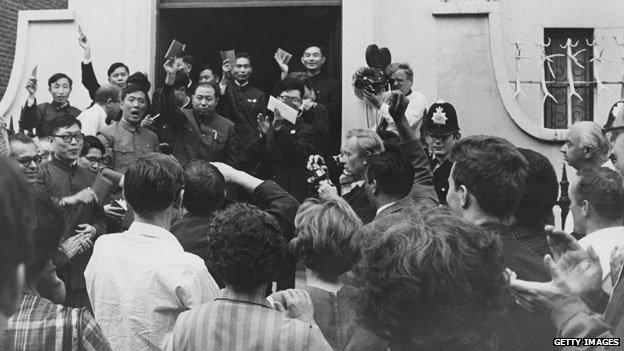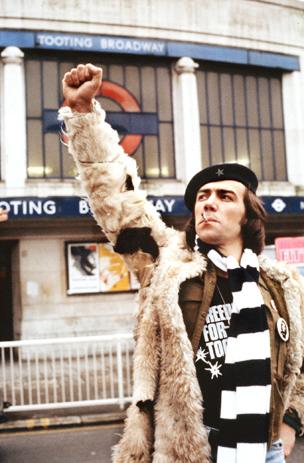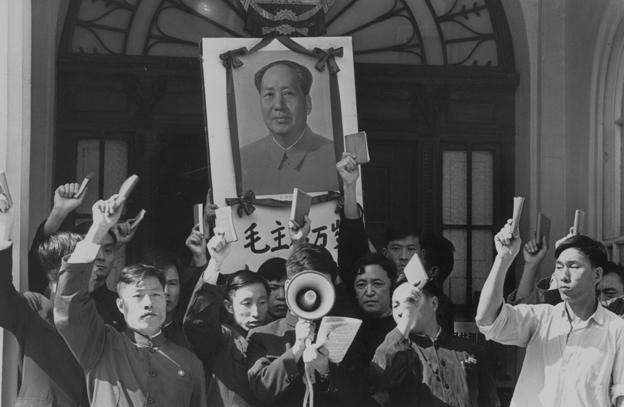How common were Maoist groups in 1970s Britain?
- Published

British supporters of the communist People's Republic of China listen as a Chinese diplomat exclaims 'Long live Chairman Mao'
The couple accused of holding three women as slaves for more than 30 years were activists in a Maoist group in London. It was a period when the UK had a plethora of small left-wing collectives and communes.
Aravindan Balakrishnan, known as Comrade Bala, and his wife Chanda ran a bookshop and commune from a large building in Brixton.
Balakrishnan had been a member of the Communist Party of England (Marxist-Leninist) in the early 1970s but split and formed his own collective in 1974 - the Workers' Institute of Marxism-Leninism-Mao Zedong Thought. It comprised about 25 people.
The group was not unusual. There were about 20 Maoist groups active in the UK in the 1970s, says Michel Hockx, director of the SOAS China Institute at SOAS, University of London. All followed the ideology of Chinese communist leader, Mao Zedong, who put industry under state ownership, collectivised farming and ruthlessly suppressed opposition.
"All [the UK groups] considered themselves Maoists, but they fought against each other about who was in possession of the right ideology," he says.

The left-wing radicalism of the era was lampooned in TV comedy Citizen Smith
"Some were fairly militant, they would actively promote overthrowing the capitalist systems and class systems. Others practised communal living, equality as a group."
In some of the groups work would be collectively organised, people took meals together, shared possessions and would take part in political planning together.
"Whatever they produced would be divided among each other according to how much work they did, or more ideologically, by how much they needed it," adds Hockx.
It wasn't just Maoists, there was a great deal of other radical activism at the time.
"There was general ferment in society. In terms of radical politics people were very engaged by the war in Vietnam, significant numbers of young people were protesting about that," says Prof Dennis Tourish, author of The Dark Side of Transformational Leadership.
"It was also the three-day week, the collapse of Franco in Spain, the 1968 Paris riots, there had been the assassination of Kennedy and Martin Luther King. There was a mood of radicalisation. Many people were drawn to far left causes at one time or another."
Robert Griffiths, general secretary of the Communist Party of Britain, has described Balakrishnan's Maoist sect, external as the "breakaway of a breakaway of a breakaway".
The term used was "splittist". Groups would part company and suspend members who did not toe the party line or presented a different view of the same ideology. Fringe groups would then form, often creating angry rivalries with their former comrades.
"Each spilt had its own pope, its divine leader, but they were all trying to colonise the same belief systems," adds Tourish.
Left-wing groups were active across the UK, but in Brixton in south London, there was a ready supply of short-term empty houses in neighbourhoods that Lambeth Council was gradually clearing for its housing programmes. It provided ample choice for people looking to set up squats and communes.
"There were also plenty of empty or under-used small shop premises, like that at Acre Lane, which has been linked with the Mao Zedong Memorial Trust," says Alan Piper, of the Brixton Society.
"Some of these groups took a closer interest in local affairs, and went on to organise squats or housing co-ops or print workshops, or even to contest local council elections.
"Others were more oriented to national or international causes, so had a lower profile in the immediate area," he adds.
Not all of the fringe groups were based around communes.
The Workers' Revolutionary Party encouraged their members to share accommodation, according to Tourish, but it was not mandatory.
"They had a number of other techniques to draw in members and reinforce their commitment," he says.

"It was only a small party - at its peak it had around 1,000 people - but for example they put huge effort into producing a daily newspaper which they would then spend their days trying to sell, and being ignored and ridiculed for it.
"That effort raised their commitment, and gave the members a very powerful group identity."
Nick Cohen, author of What's Left?, has written that hard work reinforced loyalty, external.
"They have committed all that time, all that hope and enthusiasm, how can they admit it has all been for nothing?"
There were some people at the time that worried that some of the groups that advocated communal living had echoes of cults.
"People were starting to worry about young people who had joined a group or who had quite extreme beliefs or sought out alternative ways of living," says Dr Suzanne Newcombe of the charity Inform.
"It wasn't just political - there were religious cults, utopian groups.
"There was also a deep mistrust in our society's traditional authority figures, and in response some blindly trusted alternative authority figures."
Follow @BBCNewsMagazine, external on Twitter and on Facebook, external
- Published20 September 2013